Origin
During the 7th Century AD Songstem Gampo [སྲོང་བཙན་སྒམ་པོ་] (569-649AD), the 33rd king of the Yarlung Dynasty of southern Tibet and the first Emperor of Tibet, sent Thonmi Sambhota, one of his ministers, to India to gather information on Buddhism. The minister then reputedly devised a script for Tibetan based on the Devanagari model and also wrote a grammar of Tibetan based on Sanskrit grammars.The new Tibetan alphabet was used to write Tibetan translations of Buddhists texts. The first Sanskrit-Tibetan dictionary, Mahavyutpatti, appeared in the 9th century. Wood block printing, introduced from China, was used in Tibet from an early date and is still used in a few monasteries.
Tibetan literature is mainly concerned with Buddhist themes and includes works translated from Sanskrit and Chinese and original Tibetan works. There are also literary works about the Bon religion, a pre-Buddhist religion indigenous to Tibet. The most unusual genre of Tibetan literature is that of gter-ma (གཏེར་མ་) or 'rediscovered' texts - reputedly the work of ancient masters which have been hidden in remote caves for many centuries.
Notable features
- Type of writing system: syllabic alphabet or abugida. Each letter has an inherent vowel /a/. Other vowels can be indicated using a variety of diacritics which appear above or below the main letter.
- Direction of writing: left to right in horizontal lines.
- Syllables are separated by a dot.
- Consonant clusters are written with special conjunct letters.
Used to write:
Tibetan (བོད་སྐད), a Sino-Tibetan language spoken by about 6 million people in China (Tibet, Qinghai, Gansu, Sichuan and Yunnan), India, Bhutan, Sikkim, Ladakh and Nepal. In Mongolia Tibetan is considered the Classical language of Buddhism and was widely taught until quite recently.Before 1949-50, Tibet comprised of three provinces: Amdo, now split between the Qinghai, Gansu and Sichuan provinces; Kham, now largely incorporated into the provinces of Sichuan, Yunnan and Qinghai, and U-Tsang, which, together with western Kham, is now known as the Tibet Autonomous Region, which was created in 1965.
Dzongkha (Bhutanese) (རྫོང་ཁ), which is spoken by about 130,000 people in Bhutan, where it is the national language, and also in Nepal and India. It is a Sino-Tibetan language which is quite closely related to Tibetan and distantly related to Chinese.
Sikkimese (འབྲས་ལྗོངས་སྐད་), a Southern Tibetan language spoken by about 70,300 people in Sikkim. It is closely related to Dzongkha and less closely related to Tibetan.
The Tibetan alphabet
The form of the alphabet shown below, known as u-chen (དབུ་ཅན་) is used for printing. Cursive versions of the alphabet, such as the gyuk yig or 'flowing script' (རྒྱུག་ཡིག་) are used for informal writing.Consonants
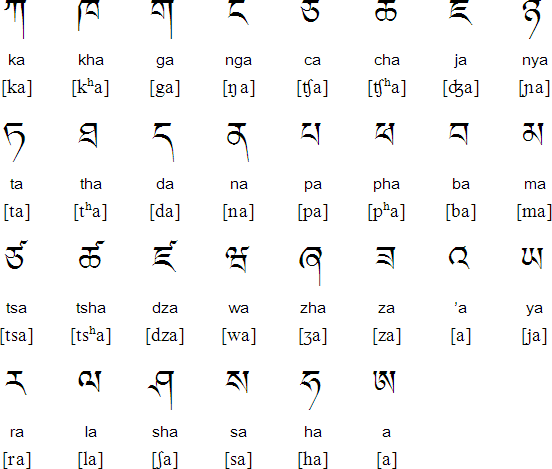
Vowels diacritics

Conjunct consonants

Note
This table includes the standard consonant combinations used for native Tibetan words. It does not include other combinations found in common loan words or the thousands of combinations used for translitterating Sanskrit words in religious texts.Source: http://sites.google.com/site/chrisfynn2/home/tibetanscriptfonts/thetibetanwritingsystem/tibetanlettercombinations
Numerals

Punctuation and other symbols
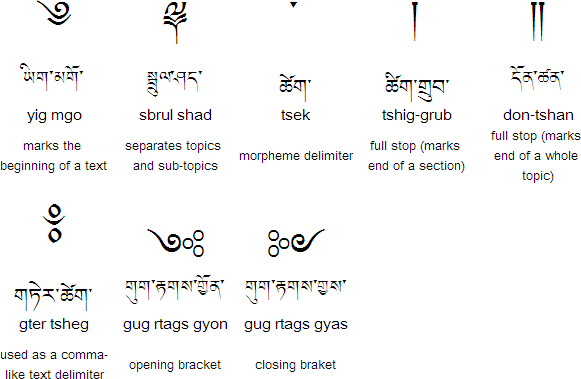
Downloads
Download a Tibetan alphabet chart in Excel, Word or PDF formatSample text - Tibetan (དབུ་ཅན་: u-chen script)
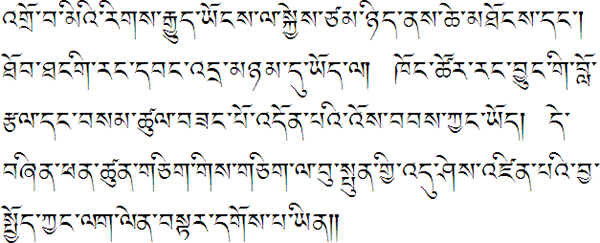
Sample text - Tibetan (རྒྱུག་ཡིག་: gyuk yig script)
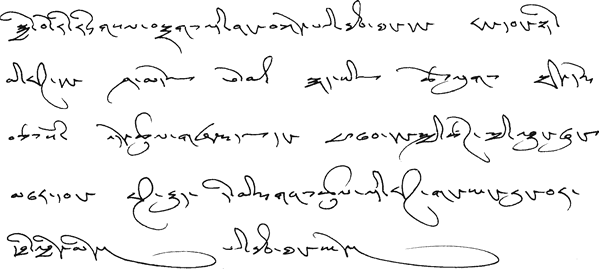
Translation
All human beings are born free and equal in dignity and rights. They are endowed with reason and conscience and should act towards one another in a spirit of brotherhood.(Article 1 of the Universal Declaration of Human Rights)
Tibetan script for Sanskrit
These are the Tibetan letters used to write Sanskrit. Some of them are not used in Tibetan.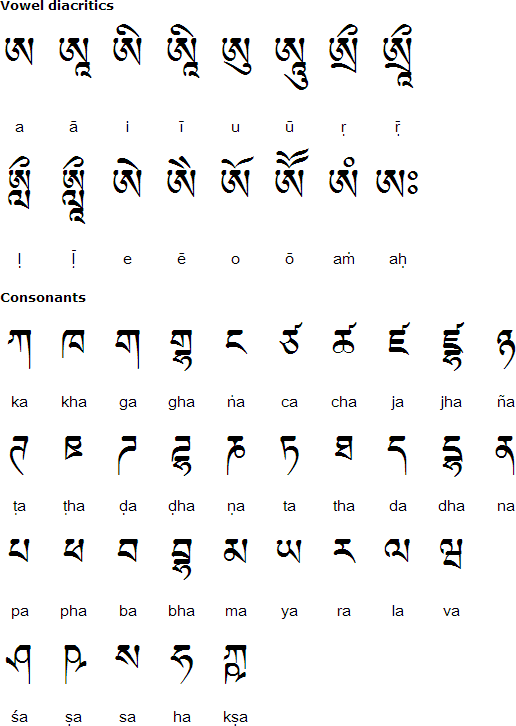
Information about Tibetan |
Tibetan phrases |
Tower of Babel in Tibetan |
Tibetan learning materials
Links
Information about the Tibetan language and alphabethttp://en.wikipedia.org/wiki/Standard_Tibetan
http://en.wikipedia.org/wiki/Tibetan_script
http://www.tibet.dk
http://www.sytra.cn/tibetan-translation-service.html
Online Tibetan lessons
http://www.blo-gros.info/index.php?id=tibetan-language
Tibetan phrases
http://library.thinkquest.org/26470/language.htm
http://www.eclipse.co.uk/tibet/lang.html
http://www.oocities.com/tibetanlanguage/language.html
Tibetan dictionaries
http://eng-tib.zanwat.org
http://www.nitartha.org/dictionary_search04.html
http://rywiki.tsadra.org/index.php/Main_Page
Nitartha international - Tibetan software and online dictionary
http://www.nitartha.org/home.html
Languages and dialects of Tibet
http://www.langues-du-tibet.net
The Tibetan language Institute - teaches Tibetan in Hamilton, Montana, USA
http://www.tibetanlanguage.org
PechaMaker - a tool for creation of Tibetan Pecha
http://www.pechamaker.com
Tibetan calligraphy
http://www.asianart.com/exhibitions/calligraphy
http://www.tashimannox.co.uk/gal.html
http://www.tibetan-calligraphy.com
Online Tibetan language news and radio
http://www.rfa.org/tibetan/
http://www.tibettimes.net
Tibetan songs
http://www.gakyi.com/tibetansongs/
Tibetan fonts and software
http://www.wazu.jp/gallery/Fonts_Tibetan.html
http://tsampa.org/tibetan/software/
http://www.nitartha.org/downloads.html
http://www.otani.ac.jp/cri/twrp/TLK/
http://www.thubtenrigzin.fr/en.html
ATTU - ANSI Tibetan to Unicode font convertor
http://www.pechamaker.com/attu/
Tibetan & Himalayan Digital Library (THDL)
http://thdl.org
Tibetan Government in Exile's Official Web Site (includes information on Tibetan language and culture): http://www.tibet.net
Khagyun: Stories from the Tibetan Diaspora
http://www.khagyun.org
Information about Tibetan medicine, buddhism and calligraphy (in French and English)
http://www.medecinetibet.org










.jpg)
.jpg)
.jpg)





0 comments:
Post a Comment
Note: Only a member of this blog may post a comment.